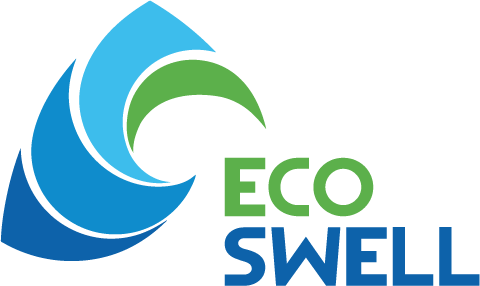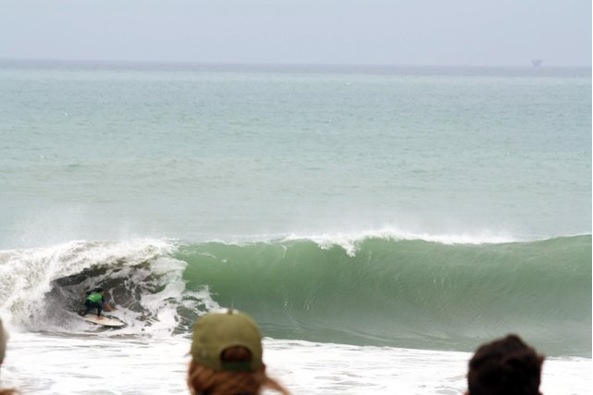The Search for Sustainable Surfing at Lobitos
Ramón Espinoza barreling deep at the final heat of the Volcom “El Hueco” 2018 competition at Lobitos, Peru. An oil rig looms at the distance on the far right corner, barely visible. The natural assets for world-class surf tourism exist in Lobitos, but do we possess the planning that it takes to make it sustainable?
Photo by Diego Almendrades (@diego-ecoswell)
Last year was an incredible year for surfing and the conservation of waves breaks in Peru, especially for Lobitos, Talara, the world-class surfing town where the main EcoSwell headquarters are located and where we deliver most of our impact through much-needed sustainability projects.
Fundraising for Surf Reserves
One of these projects started in 2016 whereby we led the local chapter of the national “Hazla Por tu Ola” campaign by Conservamos Por Naturaleza, which consisted of raising funds to get various surf breaks in Lobitos protected by Peruvian law from any further constructions, buildings or industrial developments which could affect the coastal and marine morphology that forms these perfect waves. Peru is the first country in the world to have special legislation for this, but any wave break that needs protection has to be entered into a national registry along with a specific technical study (showing information about waves, bathymetry and coastal profile for each point) which needs to be funded. Therefore, every single wave break needs to be fundraised for in order to make it into the list of waves protected by law and enforced by the Peruvian Marine.
Augusto Monsalve showing great backside technique at the Volcom “El Hueco” Lobitos 2018 final heat. The waves were firing and the competition was tight during the final. Photo by Diego Almendrades (@diego-ecoswell)
Surf tourism: a sustainable economic alternative
This marked the first big milestone of EcoSwell’s mid-term plan to turn Lobitos into a World Surfing Reserve, a program of Save The Waves Coalition which designates and preserves outstanding waves, surf zones and surrounding environments around the world. Over the past couple of decades, surfing has become an increasingly important driver for development in Lobitos in contrast with the old-fashioned and ever more unpopular oil-drilling industry, which has basically been equal to non-stop exploitation and contamination of the town’s natural resources, both on-shore, and off-shore, for more than a hundred years. Slowly but surely, local people are realizing that it is not necessary to rely on oil and fossil fuels for development and that other cleaner and more sustainable alternatives exist, like the tourism that arises from surfing.
By 2017, the total funds needed for the main breaks were obtained (S/20,000 nuevos soles or close to US$ 6,250 at the time) and finally, after much hassle with different government entities, in January 2018 the official announcement was made by the National Marine Authority of Peru protecting up to 7 different wave breaks in Lobitos: Baterías, Kandui, El Hueco, Frontera, Lobitos (La Punta), General and Piscinas. You can read the official announcement here (in Spanish).
Map showing the protected area around the “Baterías” wave break in Lobitos. Source and more maps here..
“it is not necessary to rely on oil and fossil fuels for development and that other cleaner and more sustainable alternatives exist, like the tourism that arises from surfing.”
Another perfect barrel in the final heat of the Volcom “El Hueco” Lobitos 2018 by Alvaro Malpartida, who used it to claim the title that afternoon. Check out the final results of the competition here and a video summary here. Congratulations to Alvaro and all the competitors on that big day!
Photo by Diego Almendrades (@diego-ecoswell)
However, even though the perfect waves exist (as well as their very real threats), they are the natural assets necessary for tourism but not yet a proper and sustainable touristic product. They are the assets that allow for tourism and tourism-oriented hotels and businesses to exist, but they are not yet organized within a bigger plan and framework for the locality. Sadly many times these hotels and businesses themselves, in their desire to have the best or closest spots to the waves, have built constructions so near the beach that the natural wind, sanding and beach processes that maintain the waves are affected and interrupted, effectively destroying the very thing on which their income and investment depends on and bordering on insanity. Effectively self-destructing because of short-sightedness and desire for short-term gain within the selfish free-market competition, while at the same time lacking a long-term analysis, a strong and knowledgeable authority and a community plan.
The six competitors of the final heat of the competition during the awards ceremony, showing solidarity for the friends and family of the late Bernardo “Chato Bernardo” Zignago, whom the competition was dedicated to. He was a local surfer from Lobitos who died in 2018 after a tragic accident while surfing in Panic Point, Cabo Blanco. Photo by Diego Almendrades (@diego-ecoswell)
The top 3 places of the women’s category for the Volcom “El Hueco” Lobitos 2018. More inclusivity is still pending in surfing to reach equality between women's and men's competitions in terms of exposure, attendance and award prizes. Photo by Diego Almendrades (@diego-ecoswell)
This environmental problem is very common worldwide and it showcases again and again what happens when individualism and the desire to win against your competitors beats local union and the desire to see the whole community grow stable and strong together. It is not uncommon to hear from the old-timers in Lobitos remarks about how the La Punta wave is now a shadow of its former self, from just 15 years ago, because the sand is just gone due to so many man-made constructions that block the natural course flow of the wind and sand dunes. Or even worse yet, is to see how the waves of Los Muelles hasn’t worked for almost 3 years now...
Introducing EcoSwell’s team rider and intern, Elliott Lang from South Devon, UK, whipping it hard at Piscinas, another wave break finally protected at Lobitos. Photo by local photographer Hugo Vela.
Elliott catching the high-speed train at Baterías, Lobitos. Surfing there now, knowing that it is finally protected by the rule of law, just makes the feeling and stoke so much better!
Photo by Daria Fortin (EcoSwell intern 2018)
Despite of all the problems and complexities, it is not late yet and we are still in time for a crucial turning point to help define the future of Lobitos, of its surf and of its tourism towards long-lasting sustainability. That is why EcoSwell is working with local stakeholders and national and international partners to achieve the next big step towards the conservation of the waves there and the organization of the surf tourism economy around it. Later in 2018, we finished designing the local Surfonomics survey study and fieldwork questionnaire, following the previous examples of other world-renowned surf spots like Huanchaco, Pichilemu and Mundaka. Surfonomics is a market research study to determine the economic value of waves and surfing for local communities, in order to help decision makers make better informed decisions to protect their coastal resources. For more information about Surfonomics check out our previous post and for more about previous stories check these case studies.
On October 2018, we began the fieldwork phase of the Surfonomics study in Lobitos and started surveying tourists. In November 2018, right in the middle of our Surfonomics study, Lobitos hosted the prestigious Volcom “El Hueco” Competition. Two days where the best surfers from Peru gathered for some of the most insane barrels at the ultimate water temple here. It felt good witnessing this competition and realizing it was the first one after the official protection of the waves. The first chapters in a long-coming history of preservation which show the enormous potential that this event can have over time if things are done properly for sustainable use of these precious natural assets.
To take advantage of the unusual flow of people to Lobitos for this big event, EcoSwell and Lobitos Cinema Project co-organized two local screening nights of the documentary “A La Mar (teaser)” in order to coincide with the competition, raise more awareness of the conservation issues that surfing and ocean-related activities are facing and get the local discussion rolling. This documentary portrays the whole story behind the “Hazla Por tu Ola” campaign in Peru and the protection of the first iconic and threatened break of the country: mythical Cabo Blanco. Both screening nights were smash hits.
The EcoSwell Surfonomics fieldwork team of 2018, ready to get more surfer tourists for the surveys. Photo by Diego Almendrades (@diego-ecoswell)
“it is not late yet and we are still in time for a crucial turning point to help define the future of Lobitos, of its surf and of its tourism towards long-lasting sustainability.”
Our Surfonomics study is continuing head-on through 2019, thanks to EcoSwell’s amazing team of interns and volunteers, who go out every week hunting for surfers to fill out the questionnaires. In this way we will obtain solid surfonomics data throughout a whole year and be able to draw sound conclusions from this study. Hopefully by 2020, everything will be in place to apply as a World Surfing Reserve and improve the prestige, the protection status and the organization of the surfing economy at Lobitos. Will we become a good or a bad example? The choice is in our hands and all support is dearly welcomed to act now before we pass the point of no return!









